You’ll have to forgive the truncated newsletter this week. Turns out I brought more back from Chicago than a couple of robot stress balls (the one piece of swag I will gladly accept). I was telling someone ahead of the ProMat trip that I’ve returned to 2019 travel levels this year. One bit I’d forgotten was the frequency and severity of convention colds — “con crud,” as my comics friends used to call it.
I’ve been mostly housebound for the last few days, dealing with this special brand of Chicago-style deep-dish viral infection. The past three years have no doubt hobbled my immune system, but after catching COVID-19 three times, it’s frankly refreshing to have a classic, good old-fashioned head cold. Sometimes you want the band you see live to play the hits, you know? I’m rediscovering the transformative properties of honey in a cup of tea.
The good news for me is that (and, hopefully, you) is I’ve got a trio of interviews from ProMat that I’ve been wanting to share in Actuator. As I said last week, the trip was really insightful. At one of the after-show events, someone asked me how one gets into tech journalism. It’s something I’ve been asked from time to time, and I always have the same answer. There are two paths in. One is as a technologist; the other is as a journalist.
It’s obvious on the face of it. But the point is that people tend to enter the field in one of two distinct ways. Either they love writing or they’re really into tech. I was the former. I moved to New York City to write about music. It’s something I still do, but it’s never fully paid the bills. The good news for me is I sincerely believe it’s easier to learn about technology than it is to learn how to be a good writer.
I suspect the world of robotics startups is similarly bifurcated. You enter as either a robotics expert or someone with a deep knowledge of the field that’s being automated. I often think about the time iRobot CEO Colin Angle told me that, in order to become a successful roboticist, he first had to become a vacuum salesman. He and his fellow co-founders got into the world through the robotics side. And then there’s Locus robotics, which began as a logistics company that started building robots out of necessity.
Both approaches are valid, and I’m not entirely sure one is better than the other, assuming you’re willing to surround yourself with assertive people who possess deep knowledge in areas where you fall short. I don’t know if I entirely buy the old adage that there’s no such thing as a dumb question, but I do believe that dumb questions are necessary, and you need to get comfortable asking them. You also need to find a group of people you’re comfortable asking. Smart people know the right dumb questions to ask.
Covering robotics has been a similar journey for me. I learned as much about supply chain/logistics as the robots that serve them at last week’s event. That’s been an extremely edifying aspect of writing about the space. In robotics, no one really gets to be a pure roboticist anymore.
Q&A with Rick Faulk
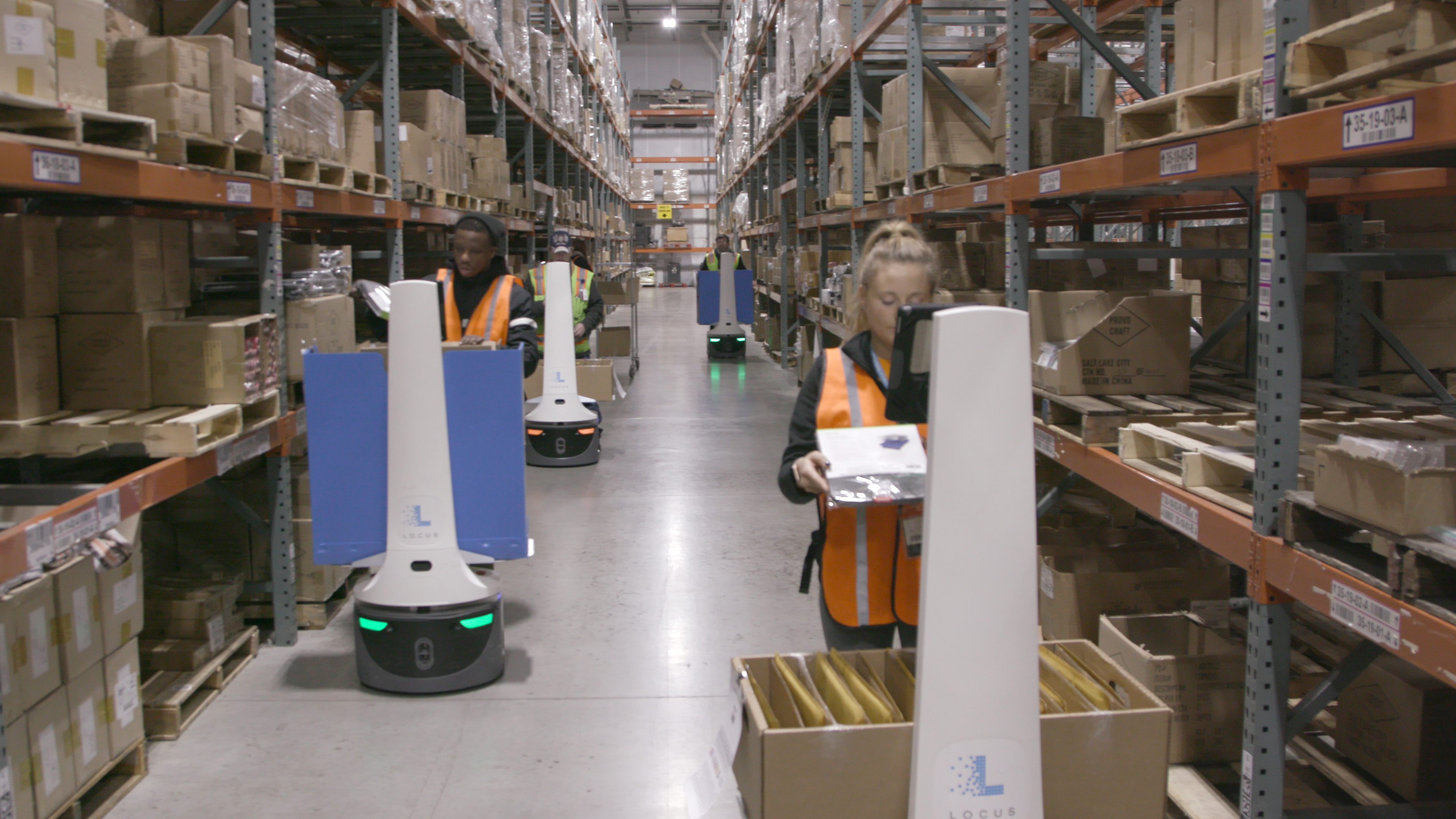
Image Credits: Locus Robotics
I’m gonna kick things off this week with highlights from a trio of ProMat interviews. First up is Locus Robotics CEO, Rick Faulk. The full interview is here.
TC: You potentially have the foundation to automate the entire process.
RF: We absolutely do that today. It’s not a dream.
Lights out?
It’s not lights out. Lights out might happen 10 years from now, but the ROI is not there to do it today. It may be there down the road. We’ve got advanced product groups working on some things that are looking at how to get more labor out of the equation. Our strategy is to minimize labor over time. We’re doing integrations with Berkshire Grey and others to minimize labor. To get to a dark building is going to be years away.
Have you explored front-of-house — retail or restaurants?
We have a lot of calls about restaurants. Our strategy is to focus. There are 135,000 warehouses out there that have to be automated. Less than 5% are automated today. I was in Japan recently, and my meal was filled by a robot. I look around and say, “Hey, we could do that.” But it’s a different market.
What is the safety protocol? If a robot and I are walking toward each other on the floor, will it stop first?
It will stop or they’ll navigate around. It’s unbelievably smart. If you saw what happened on the back end — it’s dynamically planning paths in real time. Each robot is talking to other robots. This robot will tell this robot over here, “You can’t get through here, so go around.” If there’s an accident, we’ll go around it.
They’re all creating a large, cloud-based map together in real time.
That’s exactly what it is.
When was the company founded?
[In] 2014. We actually spun out of a company called Quiet Logistics. It was a 3PL. We were fully automated with Kiva. Amazon bought Kiva in 2012, and said, “We’re going to take the product off the market.” We looked for another robot and couldn’t find one, so we decided to build one.
The form factors are similar.
Their form factor is basically the bottom. It goes under a shelf and brings the shelf back to the station to do a pick. The great thing about our solution is we can go into a brownfield building. They’re great and they work, but it will also take four times the number of robots to do the same work our robots do.
Amazon keeps coming up in my conversations in the space as a motivator for warehouses to adopt technologies to remain competitive. But there’s an even deeper connection here.
Amazon is actually our best marketing organization. They’re setting the bar for SLAs (service-level agreements). Every single one of these 3PLs walking around here [has] to do same- or next-day delivery, because that’s what’s being demanded by their clients.
Do the systems’ style require in-person deployment?
The interesting thing during COVID is we actually deployed a site over FaceTime.
Someone walked around the warehouse with a phone?
Yeah. It’s not our preferred method. They probably actually did a better job than we did. It was terrific.
As far as efficiency, that could make a lot of sense, moving forward.
Yeah. It does still require humans to go in, do the installation and training — that sort of thing. I think it will be a while before we get away from that. But it’s not hard to do. We take folks off the street, train them and in a month they know how to deploy.
Where are they manufactured?
We manufacture them in Boston, believe it or not. We have contract manufacturers manufacturing some components, like the base and the mast. And then we integrate them together in Boston. We do the final assembly and then do all the shipments.
As you expand sales globally, are there plans to open additional manufacturing sites?
We will eventually. Right now we’re doing some assemblies in Amsterdam. We’re doing all refurbishments for Europe in Amsterdam. […] There’s a big sustainability story, too. Sustainability is really important to big clients like DHL. Ours is an inherently green model. We have over 12,000 robots in the field. You can count the number of robots we’ve scrapped on two hands. Everything gets recycled to the field. A robot will come back after three or four years and we’ll rewrap it. We may have to swap out a camera, a light or something. And then it goes back into service under a RaaS model.
What happened in the cases where they had to be scrapped?
They got hit by forklifts and they were unrepairable. I mean crushed.
Any additional fundraising on the horizon?
We’ve raised about $430 million, went through our Series F. Next leg in our financing will be an IPO. Probably. We have the numbers to do it now. The market conditions are not right to do it, for all the reasons you know.
Do you have a rough timeline?
It will be next year, but the markets have got to recover. We don’t control that.
Q&A with Jerome Dubois
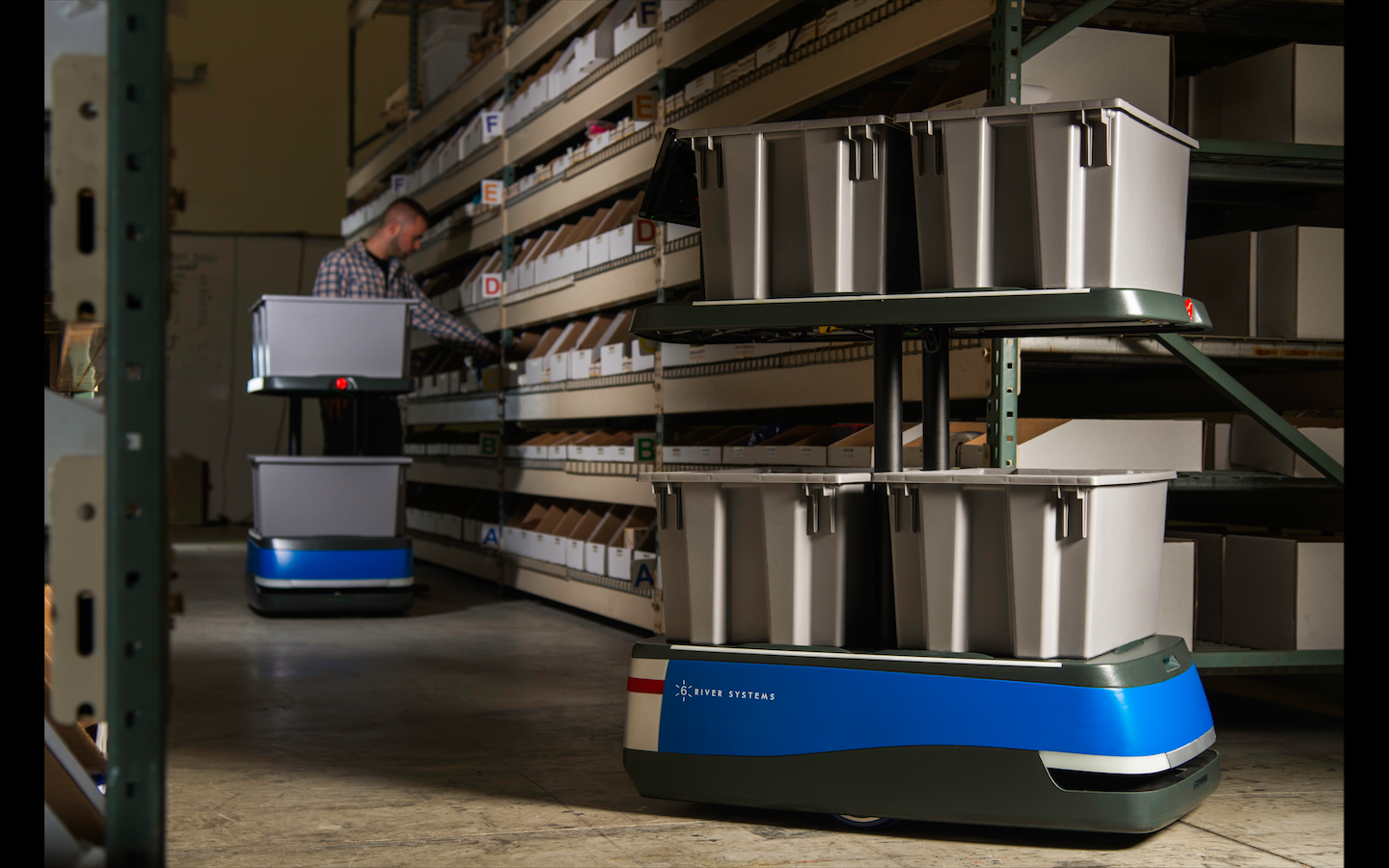
Image Credits: 6 River Systems
Next up, fittingly, is Jerome Dubois, the co-founder of Locus’ chief competitor, 6 River Systems (now a part of Shopify). Full interview here.
TC: Why was [the Shopify acquisition] the right move? Had you considered IPO’ing or moving in a different direction?
JD: In 2019, when we were raising money, we were doing well. But Shopify presents itself and says, “Hey, we’re interested in investing in the space. We want to build out a logistics network. We need technology like yours to make it happen. We’ve got the right team; you know about the space. Let’s see if this works out.”
What we’ve been able to do is leverage a tremendous amount of investment from Shopify to grow the company. We were about 120 employees at 30 sites. We’re at 420 employees now and over 110 sites globally.
Amazon buys Kiva and cuts off third-party access to their robots. That must have been a discussion you had with Shopify.
Up front. “If that’s what the plan is, we’re not interested.” We had a strong positive trajectory; we had strong investors. Everyone was really bullish on it. That’s not what it’s been. It’s been the opposite. We’ve been run independently from Shopify. We continue to invest and grow the business.
From a business perspective, I understand Amazon’s decision to cut off access and give itself a leg up. What’s in it for Shopify if anyone can still deploy your robots?
Shopify’s mantra is very different from Amazon. I’m responsible for Shopify’s logistics. Shopify is the brand behind the brand, so they have a relationship with merchants and the customers. They want to own a relationship with the merchant. It’s about building the right tools and making it easier for the merchant to succeed. Supply chain is a huge issue for lots of merchants. To sell the first thing, they have to fulfill the first thing, so Shopify is making it easier for them to print off a shipping label.
Now, if you’ve got to do 100 shipping letters a day, you’re not going to do that by yourself. You want us to fulfill it for you, and Shopify built out a fulfillment network using a lot of third parties, and our technology is the backbone of the warehouse.
Watching you — Locus or Fetch — you’re more or less maintaining a form factor. Obviously, Amazon is diversifying. For many of these customers, I imagine the ideal robot is something that’s not only mobile and autonomous, but also actually does the picking itself. Is this something you’re exploring?
Most of the AMR (autonomous mobile robot) scene has gotten to a point where the hardware is commoditized. The robots are generally pretty reliable. Some are maybe higher quality than others, but what matters the most is the workflows that are being enacted by these robots. The big thing that’s differentiating Locus and us is, we actually come in with predefined workflows that do a specific kind of work. It’s not just a generic robot that comes in and does stuff. So you can integrate it into your workflow very quickly, because it knows you want to do a batch pick and sortation. It knows that you want to do discreet order picking. Those are all workflows that have been predefined and prefilled in the solution.
With respect to the solving of the grabbing and picking, I’ve been on the record for a long time saying it’s a really hard problem. I’m not sure picking in e-comm or out of the bin is the right place for that solution. If you think about the infrastructure that’s required to solve going into an aisle and grabbing a pink shirt versus a blue shirt in a dark aisle using robots, it doesn’t work very well, currently. That’s why goods-to-person makes more sense in that environment. If you try to use arms, a Kiva-like solution or a shuttle-type solution, where the inventory is being brought to a station and the lighting is there, then I think arms are going to be effective there.
Are these the kinds of problems you invest R&D in?
Not the picking side. In the world of total addressable market — the industry as a whole, between Locus, us, Fetch and others — is at maybe 5% penetration. I think there’s plenty of opportunity for us to go and implement a lot of our technology in other places. I also think the logical expansion is around the case and pallet operations.
Interoperability is an interesting conversation. No one makes robots for every use case. If you want to get near full autonomous, you’re going to have a lot of different robots.
We are not going to be a fit for 100% of the picks in the building. For the 20% that we’re not doing, you still leverage all the goodness of our management consoles, our training and that kind of stuff, and you can extend out with [the mobile fulfillment application]. And it’s not just picking. It’s receiving, it’s put away and whatever else. It’s the first step for us, in terms of proving wall-to-wall capabilities.
What does interoperability look like beyond that?
We do system interoperability today. We interface with automation systems all the time out in the field. That’s an important part of interoperability. We’re passing important messages on how big a box we need to build and in what sequence it needs to be built.
When you’re independent, you’re focused on getting to portability. Does that pressure change when you’re acquired by a Shopify?
I think the difference with Shopify is, it allows us to think more long-term in terms of doing the right thing without having the pressure of investors. That was one of the benefits. We are delivering lots of longer-term software bets.
Q&A with Peter Chen
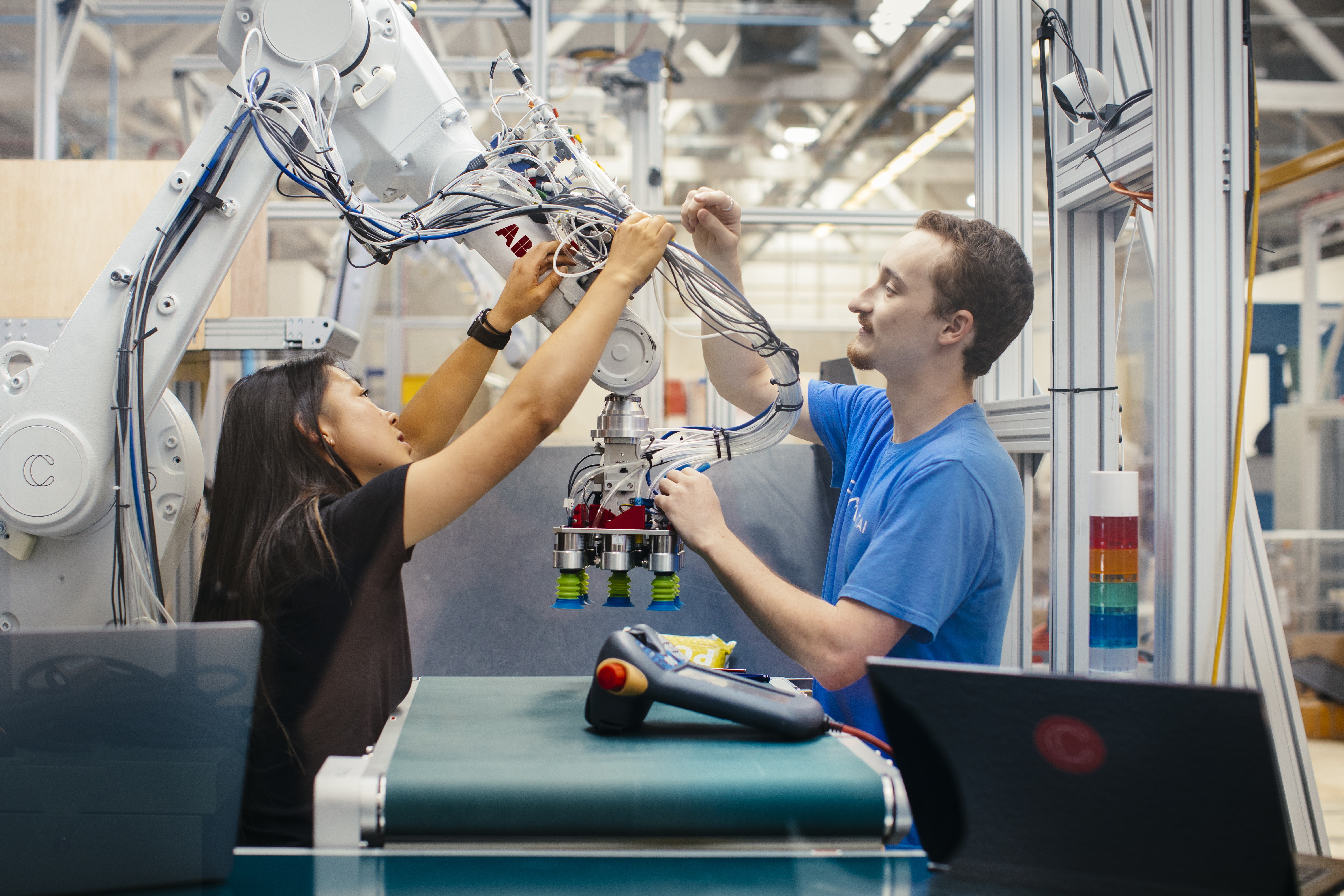
Image Credits: Covariant
Lastly, since I’ve chatted with co-founder Pieter Abbeel a number of times over the years, it felt right to have a formal conversation with Covariant CEO Peter Chen. Full interview here.
TC: A lot of researchers are taking a lot of different approaches to learning. What’s different about yours?
PC: A lot of the founding team was from OpenAI — like three of the four co-founders. If you look at what OpenAI has done in the last three to four years to the language space, it’s basically taking a foundation model approach to language. Before the recent ChatGPT, there were a lot of natural language processing AIs out there. Search, translate, sentiment detection, spam detection — there were loads of natural language AIs out there. The approach before GPT is, for each use case, you train a specific AI to it, using a smaller subset of data. Look at the results now, and GPT basically abolishes the field of translation, and it’s not even trained to translation. The foundation model approach is basically, instead of using small amounts of data that’s specific to one situation or train a model that’s specific to one circumstance, let’s train a large foundation-generalized model on a lot more data, so the AI is more generalized.
You’re focused on picking and placing, but are you also laying the foundation for future applications?
Definitely. The grasping capability or pick and place capability is definitely the first general capability that we’re giving the robots. But if you look behind the scenes, there’s a lot of 3D understanding or object understanding. There are a lot of cognitive primitives that are generalizable to future robotic applications. That being said, grasping or picking is such a vast space we can work on this for a while.
You go after picking and placing first because there’s a clear need for it.
There’s clear need, and there’s also a clear lack of technology for it. The interesting thing is, if you came by this show 10 years ago, you would have been able to find picking robots. They just wouldn’t work. The industry has struggled with this for a very long time. People said this couldn’t work without AI, so people tried niche AI and off-the-shelf AI, and they didn’t work.
Your systems are feeding into a central database and every pick is informing machines how to pick in the future.
Yeah. The funny thing is that almost every item we touch passes through a warehouse at some point. It’s almost a central clearing place of everything in the physical world. When you start by building AI for warehouses, it’s a great foundation for AI that goes out of warehouses. Say you take an apple out of the field and bring it to an agricultural plant — it’s seen an apple before. It’s seen strawberries before.
That’s a one-to-one. I pick an apple in a fulfillment center, so I can pick an apple in a field. More abstractly, how can these learnings be applied to other facets of life?
If we want to take a step back from Covariant specifically, and think about where the technology trend is going, we’re seeing an interesting convergence of AI, software and mechatronics. Traditionally, these three fields are somewhat separate from each other. Mechatronics is what you’ll find when you come to this show. It’s about repeatable movement. If you talk to the salespeople, they tell you about reliability, how this machine can do the same thing over and over again.
The really amazing evolution we have seen from Silicon Valley in the last 15 to 20 years is in software. People have cracked the code on how to build really complex and highly intelligent looking software. All of these apps we’re using [are] really people harnessing the capabilities of software. Now we are at the front seat of AI, with all of the amazing advances. When you ask me what’s beyond warehouses, where I see this really going is the convergence of these three trends to build highly autonomous physical machines in the world. You need the convergence of all of the technologies.
You mentioned ChatGPT coming in and blindsiding people making translation software. That’s something that happens in technology. Are you afraid of a GPT coming in and effectively blindsiding the work that Covariant is doing?
That’s a good question for a lot of people, but I think we had an unfair advantage in that we started with pretty much the same belief that OpenAI had with building foundational models. General AI is a better approach than building niche AI. That’s what we have been doing for the last five years. I would say that we are in a very good position, and we are very glad OpenAI demonstrated that this philosophy works really well. We’re very excited to do that in the world of robotics.
News of the week
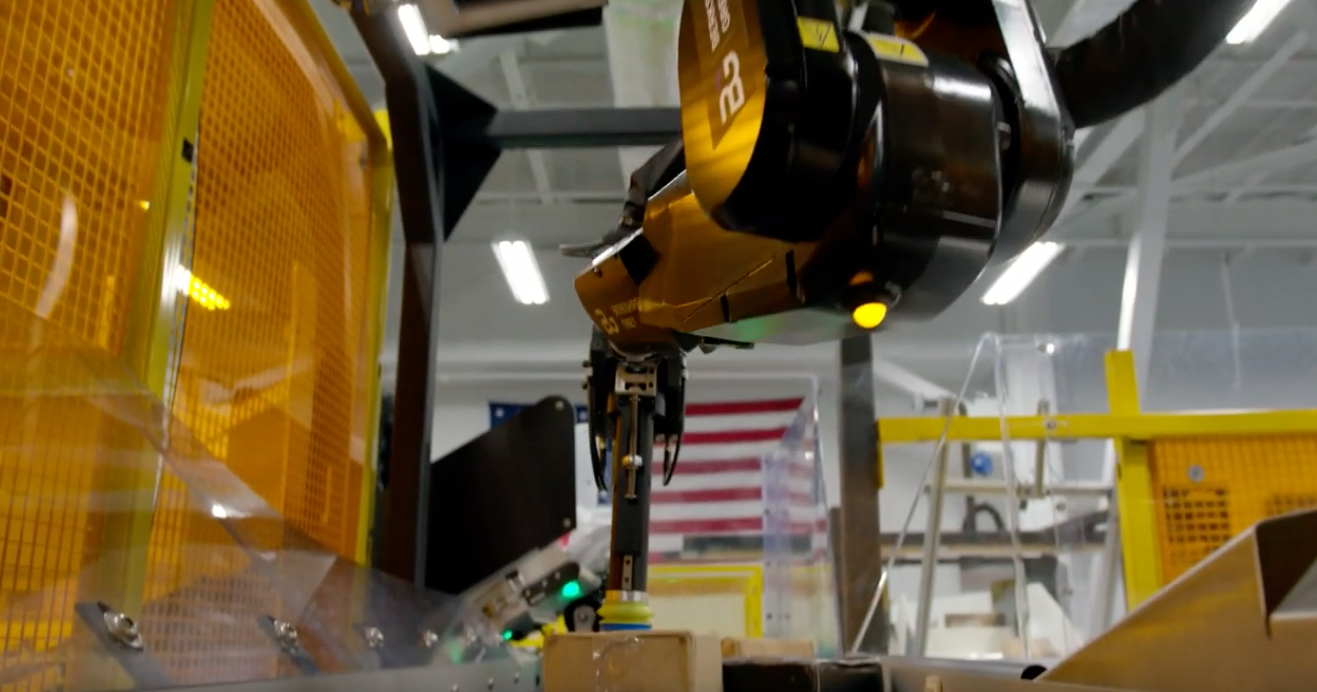
Image Credits: Berkshire Grey
The big news of the week quietly slipped out the day after ProMat drew to a close. Berkshire Grey, which had a strong presence at the event, announced on Friday a merger agreement that finds SoftBank Group acquiring all outstanding capital stock it didn’t already own. The all-cash deal is valued at around $375 million.
The post-SPAC life hasn’t been easy for the company, in spite of a generally booming market for logistics automation. Locus CEO Rick Faulk told me above that the company plans to IPO next year, after the market settles down. The category is still a young one, and there remains an open question around how many big players will be able to support themselves. For example, 6 River Systems and Fetch have both been acquired, by Shopify and Zebra, respectively.
“After a thoughtful review of value creation opportunities available to Berkshire Grey, we are pleased to have reached this agreement with SoftBank, which we believe offers significant value to our stockholders,” CEO Tom Wagner said in a release. “SoftBank is a great partner and this merger will strengthen our ability to serve customers with our disruptive AI robotics technology as they seek to become more efficient in their operations and maintain a competitive edge.”
Unlike the Kiva deal that set much of this category in motion a decade ago, SoftBank maintains that it’s bullish about offering BG’s product to existing and new customers. Says managing partner, Vikas J. Parekh:
As a long-time partner and investor in Berkshire Grey, we have a shared vision for robotics and automation. Berkshire Grey is a pioneer in transformative, AI-enabled robotic technologies that address use cases in retail, eCommerce, grocery, 3PL, and package handling companies. We look forward to partnering with Berkshire Grey to accelerate their growth and deliver ongoing excellence for customers.
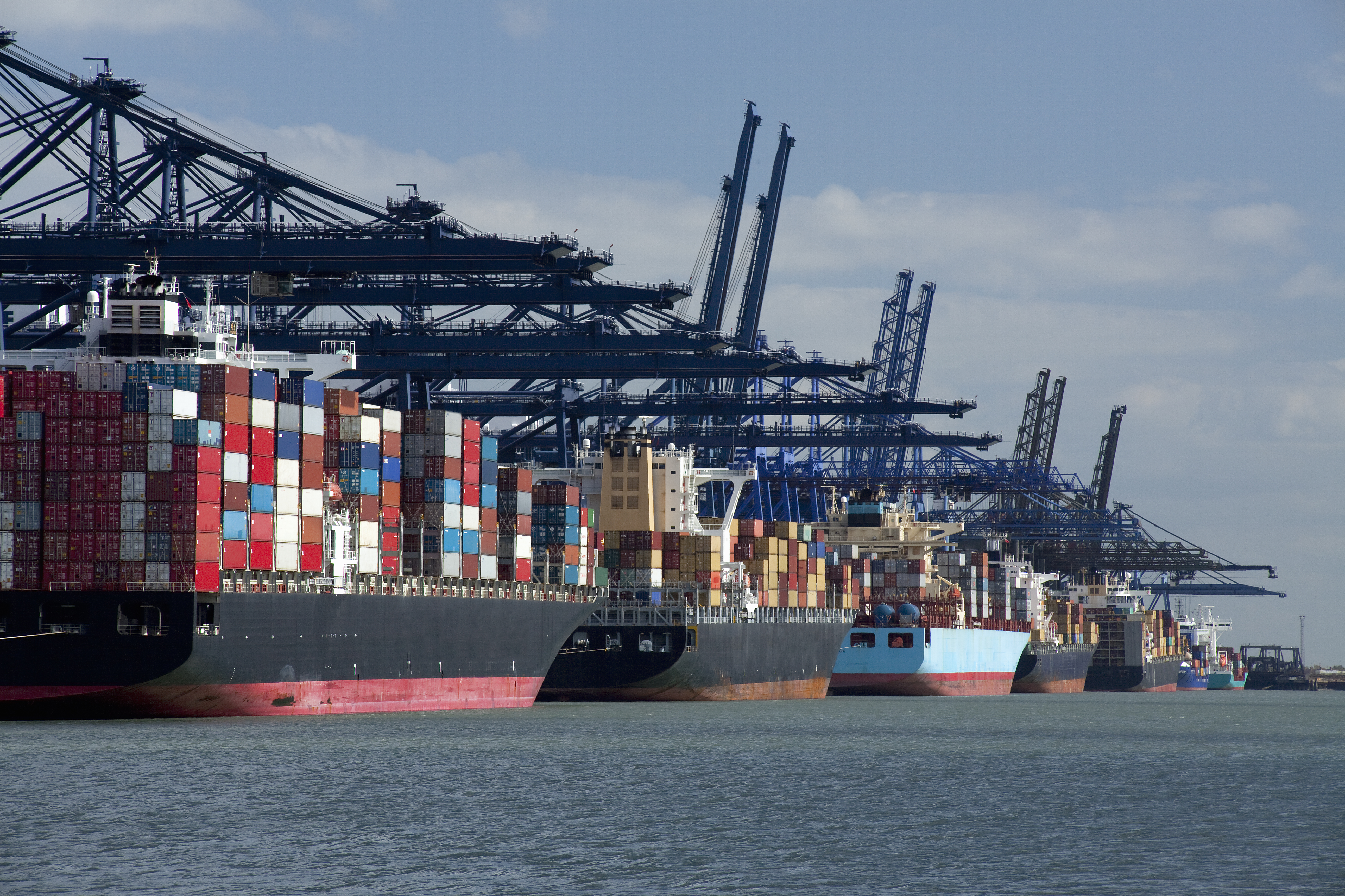
Image Credits: John Lamb / Getty Images
A healthy Series A this week from Venti Technologies. The Singapore/U.S. firm, whose name translates to “large Starbucks cup,” raised $28.8 million, led by LG Technology Ventures. The startup is building autonomous systems for warehouses, ports and the like.
“If you have a big logistics facility where you run vehicles, the largest cost is human capital: drivers,” co-founder and CEO Heidi Wyle tells TechCrunch. “Our customers are telling us that they expect to save over 50% of their operations costs with self-driving vehicles. Think they will have huge savings.”

Image Credits: Neubility / Neubility
This week in fun pivots, Neubility is making the shift from adorable last-mile delivery robots to security bots. This isn’t the company’s first pivot, either. Kate notes that it’s now done so five times since its founding. Fifth time’s the charm, right?
Neubility currently has 50 robots out in the world, a number it plans to raise significantly, with as many as 400 by year’s end. That will be helped along by the $2.6 million recently tacked onto its existing $26 million Series A.
Model-Prime emerged out of stealth this week with a $2.3 million seed round, bringing its total raise to $3.3 million. The funding was led by Eniac Ventures and featured Endeavors and Quiet Capital. The small Pittsburgh-based firm was founded by veterans of the self-driving world, Arun Venkatadri and Jeanine Gritzer, who were seeking a way to create reusable data logs for robotics companies.
The startup says its tech, “handles important tasks like pulling the metadata, automated tagging, and making logs searchable. The vision is to make the robotics industry more like web apps, or mobile apps, where it now seems silly to build your own data solution when you could just use Datadog or Snowflake instead.”
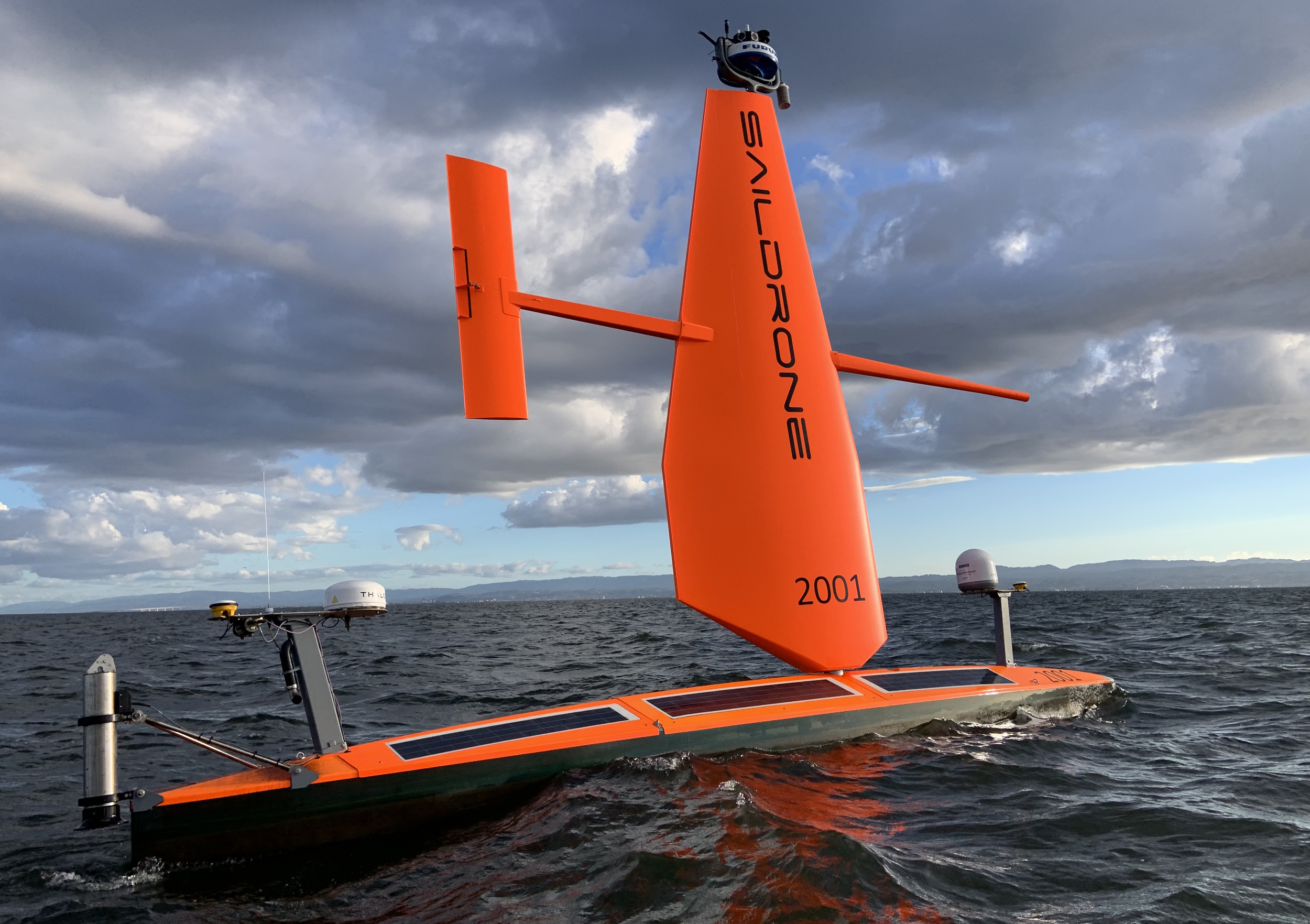
Image Credits: Saildrone
Saildrone, meanwhile, is showcasing Voyager, a 33-foot uncrewed water vehicle. The system sports cameras, radar and an acoustic system designed to map a body of water down to 900 feet. The company has been testing the boat out in the world since last February and is set to begin full-scale production at a rate of a boat a week.
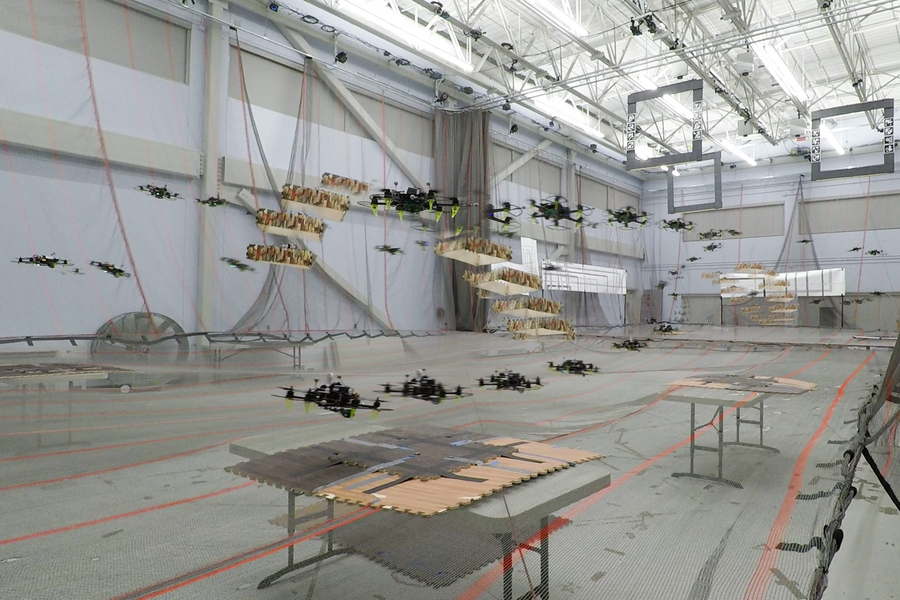
Image Credits: MIT
Finally, some research out of MIT. Robust MADER is a new version of MADER, which the team introduced in 2020 to help drones avoid in-air collisions.
“MADER worked great in simulations, but it hadn’t been tested in hardware. So, we built a bunch of drones and started flying them,” says grad student Kota Kondo. “The drones need to talk to each other to share trajectories, but once you start flying, you realize pretty quickly that there are always communication delays that introduce some failures.”
The new version adds in a delay before setting out on a new trajectory. That added time will allow it to receive and process information from fellow drones and adjust as needed. Kondo adds, “If you want to fly safer, you have to be careful, so it is reasonable that if you don’t want to collide with an obstacle, it will take you more time to get to your destination. If you collide with something, no matter how fast you go, it doesn’t really matter because you won’t reach your destination.”
Fair enough.

Image Credits: Bryce Durbin/TechCrunch
Here you go, way too fast. Don’t slow down, you’re gonna crash. Na-na-na-na-na-na-na-na-na. (Subscribe to Actuator!)
Asking the right dumb questions by Brian Heater originally published on TechCrunch
from TechCrunch https://ift.tt/hWXSQH8
via https://ift.tt/M4u8jOJ
Comments
Post a Comment